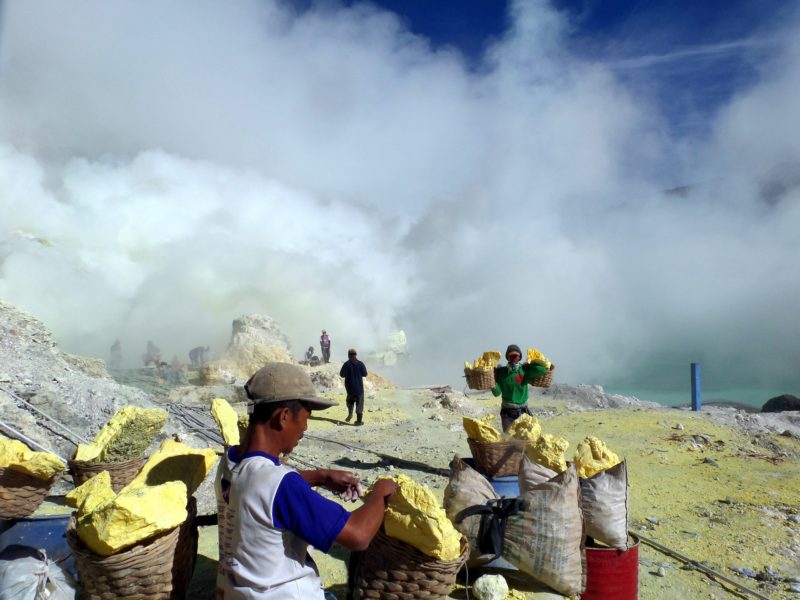Guest post by Isabelle Côté
In late 2019, a wave of violence shook the mineral-rich region of Papua, the eastern-most province of Indonesia, killing 30 people and forcing the evacuation of 11,400 others. The violence came amidst rising tensions between the growing number of internal migrants, lured to the region to work in the mines, and local Papuans who felt they were losing control over their communal farmland and natural resources.
It was not the first time that resource extraction took a contentious turn in Indonesia. In Riau province, putra daerah or “local sons” have frequently blocked oil operations in an attempt to coerce the government into handing over greater control of oil blocks to the “people of Riau” rather than Jakarta conglomerates. Elsewhere across the islands of Sumatra and Kalimantan, land conflicts related to palm oil exploitation are rampant, with police officers and security forces affiliated with palm oil companies routinely using violence on protesters.
Why do some attempts at resource exploitation lead to violent conflict?
Academic research shows that resource exploitation is often linked to armed conflicts. A closer look at the tensions surrounding natural resource extraction in Indonesia reveals that internal migration dynamics may provide added motives and opportunities for violence.
As I show in a recent article, migrants’ ownership of and employment in many of the companies that exploit natural resources marginalizes locals and threatens their lifestyle and economic subsistence. Reports show that less than 10 percent of the workforce of Riau’s major pulp and paper and oil companies are local Malays, despite the fact that they account for nearly 40 percent of the provincial population. This siphoning of local resources by internal migrants comes at a heavy cost for the local population. A local I spoke with in Riau said: “palm oil and mining companies destroy Riau’s environment. The tracks of land become fewer and smaller, to a point that Riau people eventually lose their lands to migrants and their companies.”
Local elites and organizations capitalize on such grievances, characterizing outsiders as imminent and tangible threats to the identity and economic subsistence of the native population, and as something that must be actively resisted. The recent outrage across the Indonesian archipelago over the jailing of a Sakai man for clearing a half hectare of land allegedly belonging to a palm oil company to feed his family shows how local organizations have successfully tapped into a widely perceived send of injustice to mobilize support beyond those whose livelihoods are most directly threatened by resource exploitation.
As tensions rise, companies increase security to protect their assets, which escalates the likelihood of violence and puts migrants, who are often employed in security, on the frontlines of the mining companies’ interactions with locals, as their unofficial face—and muscle.
Indonesia’s reliance on domestic population movements to supply labor for resource exploitation and national development projects limits the ability—and willingness—of the government to intervene when conflicts arise. The situation may appear calm at the moment, with few instances of widespread violence. But to quote one person I interviewed: “the situation between migrants and locals is analog to a dry leaf, which will rapidly burn when there is fire.”
The thorny relationship between internal migration and resource exploitation is not unique to Indonesia. In fact, conflicts between internal migrants and ethnically-distinct local people, which political scientists call “sons of the soil” conflict, have been part and parcel of many historical and contemporary large-scale resource development projects, including the American Gold Rush and oil exploration in Latin America. In China, the provinces of Qinghai, Gansu, and other parts of the Greater Tibetan Region have also experienced widespread protests and attacks against inter-provincial migrants working in coal mining and diamond excavation.
The story is as old as time and resonates far and wide: newcomers compete with “locals” over scarce resources and opportunities. Yet in Indonesia, China, and several other large, diverse countries, we are seeing two new twists. First, the migrants are internal rather than international, native to the country but from outside their place of work. This simultaneously makes them local outsiders but national insiders. Second, internal migrants—especially when they belong to a dominant ethnic group or are closely affiliated with the state’s apparatus—often benefit disproportionately from their relocation, deriving more financial benefits than the local population or having the upper hand when applying for jobs.
How can governments reconcile the tensions between the individual rights of some of its citizens wishing to relocate within the country’s borders, and the collective rights of other citizens who consider themselves native to a smaller parcel of the national territory and who see the mass influx of economic migrants as something that must be actively resisted? Should national interests win out over local concerns, or should local particularities dictate employment policies and other company practices?
Such tensions are not easily resolved. Most democratic countries, like Indonesia, refuse to restrict population movements within their borders, ultimately leaving it in the hands of sub-national units to act—or not. For instance, in 2001, the municipality of Batam in Indonesia implemented a bylaw curbing migration from elsewhere in Indonesia, resulting in critiques that it violated the human rights of inter-provincial migrants. One thing is clear: central governments’ inability or refusal to address the role of migration in conflict—and the desire of sub-national bodies to fill in this gap—is likely to risk unmitigated escalation of violence in the future.
Isabelle Côté is an Associate Professor in the Department of Political Science at Memorial University of Newfoundland and Labrador.







